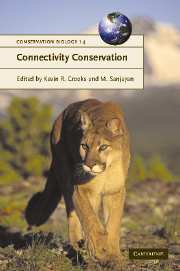Book contents
- Frontmatter
- Contents
- List of contributors
- Acknowledgements
- 1 Connectivity conservation: maintaining connections for nature
- PART I Approaches to connectivity research
- PART II Assessing connectivity
- PART III Challenges and implementation of connectivity conservation
- Introduction: Don't fence me in
- 18 Hyperconnectivity, invasive species, and the breakdown of barriers to dispersal
- 19 Disease and connectivity
- 20 Maintaining and restoring connectivity in landscapes fragmented by roads
- 21 Where to draw the line: integrating feasibility into connectivity planning
- 22 South Coast Missing Linkages: restoring connectivity to wildlands in the largest metropolitan area in the USA
- 23 Incorporating connectivity into broad-scale conservation planning
- 24 Escaping the minimalist trap: design and implementation of large-scale biodiversity corridors
- 25 The role of connectivity in Australian conservation
- 26 The future of connectivity conservation
- Index
- References
23 - Incorporating connectivity into broad-scale conservation planning
Published online by Cambridge University Press: 24 May 2010
- Frontmatter
- Contents
- List of contributors
- Acknowledgements
- 1 Connectivity conservation: maintaining connections for nature
- PART I Approaches to connectivity research
- PART II Assessing connectivity
- PART III Challenges and implementation of connectivity conservation
- Introduction: Don't fence me in
- 18 Hyperconnectivity, invasive species, and the breakdown of barriers to dispersal
- 19 Disease and connectivity
- 20 Maintaining and restoring connectivity in landscapes fragmented by roads
- 21 Where to draw the line: integrating feasibility into connectivity planning
- 22 South Coast Missing Linkages: restoring connectivity to wildlands in the largest metropolitan area in the USA
- 23 Incorporating connectivity into broad-scale conservation planning
- 24 Escaping the minimalist trap: design and implementation of large-scale biodiversity corridors
- 25 The role of connectivity in Australian conservation
- 26 The future of connectivity conservation
- Index
- References
Summary
INTRODUCTION
Conservation planning, as usually practiced, involves two fundamental tasks: (1) selection of sites that will collectively meet a set of (generally static) conservation goals, and (2) designing a network of sites that has a high probability of maintaining dynamic biodiversity and natural processes over time (Noss and Cooperrider 1994; Scott and Csuti 1997; Margules and Pressey 2000; Groves 2003). The second task addresses the issue of persistence, i.e., the long-term viability of populations and ecological functions. Connectivity is important in this context because, for example, although no single reserve might maintain a viable population of a particular species, a well-connected network of reserves might contain a viable population or metapopulation. Hence, a connected system of reserves can potentially be a whole greater than the sum of its parts (Noss and Harris 1986).
The computerized site-selection methods (algorithms) that have become the tools of the trade of conservation planning were not designed to address viability and, by themselves, poorly address connectivity and other issues of reserve design for persistence of features (Briers 2002; Cabeza 2003). In many cases the suite of sites selected by an algorithm to efficiently meet representation targets for species or ecosystems will fail to meet the needs of wide-ranging species, permit the continued operation of natural processes, or allow faunas and floras to adjust to climate change.
- Type
- Chapter
- Information
- Connectivity Conservation , pp. 587 - 619Publisher: Cambridge University PressPrint publication year: 2006
References
- 28
- Cited by



